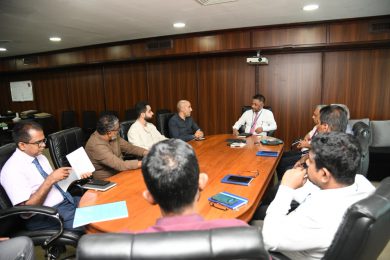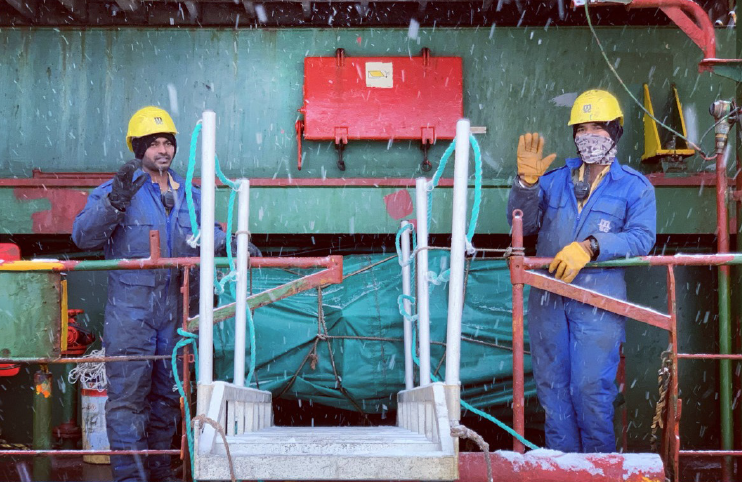by Heike Deggim, Director, Maritime Safety Division, IMO Secretariat
“What maximum winds are expected in the storm area?” That is one of Standard Marine Communication Phrases under the International Maritime Organization (IMO) that officers in charge of navigation on ships, whatever their nationality, must be able to use and understand in English.
The world’s 60 000 ocean going cargo ships are operated by some 1.6 million seafarers, traversing the globe and carrying 11 billion tons of trade annually which represents 80% of global trade.1 High winds, waves, fog and storms can be encountered on every voyage – weather that impacts the safety of navigation. This was recognized in the first International Convention for the Safety of Life at Sea (SOLAS), adopted in the wake of the infamous 1912 Titanic disaster. The 1914 SOLAS treaty established the international ice patrol, active to this day, to monitor icebergs in the North Atlantic and included a “Code for the transmission by Radiotelegraphy of Information Related to Ice, Derelicts and Weather.”2
IMO – established in 1948 as a specialized agency of the United Nations to develop standards for safe, environment-friendly, secure and efficient shipping – adopted and updated the SOLAS Convention, which now has 166 Contracting Governments, representing 98.98% of global shipping by tonnage.3 The SOLAS Safety of Navigation chapter4 sets out the Contracting Governments obligations to issue and disseminate weather information, forecasts and warnings and encourages ships to collect and exchange meteorological data. The SOLAS chapter on radiocommunications contains the provisions of the Global Maritime Distress and Safety System (GMDSS) and requires ships to have equipment on board to receive and transmit distress alerts, maritime safety information, search and rescue related communications and other general radiocommunications.
Today, the close cooperation between IMO, WMO and the International Hydrographic Organization (IHO) ensures that ships have automatic access to maritime safety information. This includes navigational warnings, meteorological warnings and forecasts through the IMO/WMO Worldwide Met-Ocean Information and Warning Service (WWMIWS)5 and the World-Wide Navigational Warning Service (WWNWS)6. The three Organizations coordinate to provide maritime safety information,7 undoubtedly contributing to safer voyage planning.
WMO works closely with IMO to support greater use of digitalization to integrate data on weather forecasts and related information into maritime services in the context of “e-navigation.” Their goal is to harmonize the collection and integration of marine information to support safety and security at sea and the protection of the marine environment. The main focus is on harmonizing the format and structure of maritime services, taking user needs into account, leading ultimately to the implementation of improved and more efficient technical services.
IMO is aware that the scarcity of data from vast areas of the ocean (so-called data-sparse areas) to support basic weather forecasting, the provision of marine meteorological and oceanographic services and climate analysis and research is a problem for both meteorology and oceanography. It encourages mariners to participate in the WMO Voluntary Observing Ships (VOS) Scheme that welcomes sea-going vessels to join in the gathering of marine meteorological and oceanographic observations to support forecasting, climate change studies and research applications.8 Today, over 4 000 ships are registered in VOS; with 2 740 identified operationally in 2020, that have submitted more than 2.5 million observations (Source: OceanOps, 2021). The reports from these ships are at times the only data available for remote areas, such as the polar regions.
Weather contributes to ships lost
Over the past decades, the number of large ships lost at sea has fallen from 130 in 2010 to 41 in 2019 – with a rolling average of 959. This progress is widely attributed to improvements in shipping safety over the years due, among other things, to wider implementation of IMO treaties, an increased focus on safety management (IMO’s International Safety Management Code was adopted in 1994) and more stringent global training standards (under IMO’s STCW10 training treaty). IMO has also been leading capacity building work to support increased coordination of port State controls – the process by which States inspect ships arriving in their ports to ensure standards are maintained. A mandatory Member State Audit Scheme is being rolled out to assess States’ abilities to meet their responsibilities as flag, port and coastal States and to offer technical assistance to fill any capacity gaps.
Nonetheless, casualty statistics reveal that “bad weather” is reported as a contributing factor in one in five ships losses.11 While the investigation into any accident may shed light on the precise chain of events leading to a loss, there is a clear need for IMO, WMO and IHO to continue to work together to explore ways to further improve accuracy and timeliness of weather forecasting and its transmission.
The challenges ahead
Climate change has led to more frequent extreme weather events, threatening livelihoods, particularly in vulnerable communities. The maritime sector needs to be aware of increased risks to shipping and ports from more intense storms.
The IMO and WMO held the first joint Symposium on Extreme Maritime Weather: Towards Safety of Life at Sea and a Sustainable Blue Economy in 2019. Key areas for urgent attention were identified, including the need for maritime users to better understand meteorological and ocean data.12 There are particular challenges for ships trading in polar regions and for ships not subject to mandatory IMO standards, such as small coastal cargo ships, large pleasure yachts and fishing vessels. There may be an abundance of commercial weather data available via mobile devices, but users need to know which data is authoritative.
Such issues must be addressed. The world has focused on more immediate challenges during the COVID-19 pandemic but it is now looking ahead to a sustainable recovery. Throughout 2020 and into 2021, seafarers and shipping have continued to deliver vital goods, including food and medical supplies, in the face of huge logistical challenges, in particular regarding global crew changes. Ensuring the safety of those seafarers against a variety of risks, including weather risks, must be a priority, as those seafarers are essential to global supply chains and economies worldwide.
Weather data and forecasting will always be key for shipping. IMO looks forward to continued cooperation with WMO in the coming years, to build on the systems established to date and ensure the resilience and responsiveness of met-ocean data for shipping.
Featured image: Seafarers on ships (Photo: Simon LeBrun)
Source: IMO























